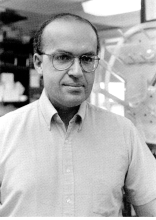Breast cancers frequently express one or more kinds of activated growth-factor receptors, and their presence correlates with poor patient prognosis. We reasoned that the level of activation of a downstream signaling protein in common to all of the receptors might provide an excellent indicator of patient prognosis (thereby helping to determine how aggressively to treat the patient). But more importantly, if the activated growth-factor receptors were actually driving the unrelenting growth of the cancer cells, then this common signaling protein might itself serve as a therapeutic target. We have made several exciting findings:
- the p52/p46 Shc signaling protein (which helps to link growth-factor receptor signaling to the Ras, Rac(?), JNK, & Myc pathways) is constitutively activated (tyrosine-phosphorylated) in most breast cancer cells, and its degree of activation correlates with overall levels of growth-factor receptor activity;
- the breast cancer cells (but not normal breast epithelial cells) require functional Shc protein in order to proliferate(evidence: expression of a potent dominant-negative p52 Shc protein profoundly inhibits signaling from endogenous Shc and blocks cell proliferation);
- Shc signaling is required for passage of the breast cancer cells (but not normal breast epithelial cells) through not only the G1, but, quite unexpectedly. also through the G2/M phases of the cell cycle;
- the expression of a 66-kDa splicing isoform of Shc is greatly reduced in breast cancer cells that are dependent upon activated p52 Shc for their ability to proliferate.
We are currently pursuing three major questions arising from these studies:
1. Do high levels of activated p52/p46 Shc and low levels of p66 Shc protein occur in actual tumor specimens? And if so, do these levels provide an indicator of patient prognosis? Our approach to address this question has been to develop antibodies that specifically recognize, respectively, either activated Shc (phospho-specific antibodies to the Shc tyrosine317 phosphorylation site), or to the p66-specific CH2 domain, and then to immunohistochemically detect and quantify the levels of these proteins.
2. What molecular pathways require Shc for passage of the breast cancer cells through the G2/M phase of the cell cycle? In order to obtain sufficient numbers of breast cancer cells arrested in G2/M by dominant-negative Shc, we are developing breast cancer cell lines that express dominant-negative Shc under the tight regulation of the Tetracycline system (see www.clontech.com/tet).
3. Is p66 Shc a tumor suppressor for breast cancer? What are the molecular control mechanisms responsible for the greatly reduced levels of p66 Shc expression in breast cancer cells? Initial experiments in this project involve forcing the breast cancer cells that lack endogenous p66 Shc to express p66 Shc, again under the tight control of the Tetracycline system.
The study of Shc in breast cancer, then, may: i) help to better predict patients with poor prognosis, thereby guiding therapeutic aggressiveness; ii) identify new therapeutic targets (Shc and its pathways) for treating breast cancers; iii) provide fundamental new insights into the molecular interactions that regulate G2/M passage and into the molecular lesions that drive breast cancer.
Davol, P.A., Garza, S., and Frackelton, A.R., Jr. Combining suramin and a chimeric toxin directed to basic fibroblast growth factor receptors increases therapeutic efficacy against human melanoma in an animal model. Cancer 86:1733-1741, 1999.
Davol, P.A., Bizuneh, A. and Frackelton, A.R., Jr. Wortmannin, a phosphatidyl 3-kinase inhibitor, potentiates the ability of certain chimeric toxins to kill tumor cells. Anticancer Research 19: 1705-1713, 1999.
Davol, P.A. and Frackelton, A.R., Jr. Targeting human prostatic carcinoma through basic fibroblast growth factor receptors in an animal model: Characterizing mechanisms of tumor resistance. Prostate 40:178-191, 1999.
Stevenson, L., Ravichandran, K.S. and Frackelton, A.R., Jr. Shc dominant negative disrupts cell cycle progression in both G0/G1 and G2/M of ErbB2 positive breast cancer cells. Cell Growth & Differentiation 10:61-71, 1999.
Stevenson, L., and Frackelton, A.R., Jr. Constitutive Shc tyrosine phosphorylation in breast cancer: Correlation with ErbB2 and p66 Shc Expression. Breast Cancer Research & Treatment 49:119-128, 1998.
Davol, P, Goullette, F., Frackelton, A.R., Jr., and Darnowski, J.W. Modulation of p53 expression by human recombinant interferon a-2a correlates with abrogation of cisplatin resistance in a human melanoma cell line. Cancer Research 56: 2522-2526, 1996.
Davol, P. and Frackelton, A.R., Jr. The mitotoxin, basic fibroblast growth factor-saporin, effectively targets human prostatic carcinoma in an animal model. J. Urology 156:1174-1179, 1996.
Nici, L., Medina, M., and Frackelton, A.R., Jr. EGF receptor on rat Type II pneumocytes after hyperoxic exposure. Amer. J. Physiol 270(2): L242-L250, 1996.
Clark, J.W., Santos-Moore, A, Stevenson, L.E., and Frackelton, A.R. Jr. Effects of tyrosine kinase inhibitors on the proliferation of human breast cancer cell lines and proteins important in the ras signaling pathway. Int. J. Cancer 65(2): 186-191, 1996.
Cheng, J.-C., Frackelton, A.R., Jr., Santos-Moore, A., Rifai, A., Kumar, P-S., Kannan, B., Bearer, E. & Clark, J. The p100 type II rasGAP is induced and complexes with tyrosine-phosphorylated p190 during PMA-induced myelomonocytic differentiation of human leukemic cells. Cell Growth & Differentiation 6:139-148, 1995.
Davol, P., Beitz, J. & Frackelton, A.R., Jr. Autocrine down-regulation of basic fibroblast growth factor receptor causes mitotoxin resistance in a human melanoma cell line. J. Invest. Dermatol. 104:916-921, (commentary p.882), 1995.

Associate Professor
Ph.D., Brown University, 1979
Roger Williams Medical Center
Prior, 215
456-2320
[email protected]